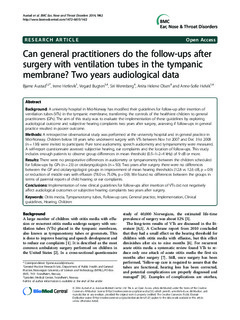| dc.contributor.author | Austad, Bjarne | |
| dc.contributor.author | Hetlevik, Irene | |
| dc.contributor.author | Bugten, Vegard | |
| dc.contributor.author | Wennberg, Siri | |
| dc.contributor.author | Olsen, Anita Helene | |
| dc.contributor.author | Helvik, Anne-Sofie | |
| dc.date.accessioned | 2015-09-22T11:53:36Z | |
| dc.date.accessioned | 2016-04-21T11:09:36Z | |
| dc.date.available | 2015-09-22T11:53:36Z | |
| dc.date.available | 2016-04-21T11:09:36Z | |
| dc.date.issued | 2014 | |
| dc.identifier.citation | BMC Ear, Nose and Throat Disorders 2014, 14(2) | nb_NO |
| dc.identifier.issn | 1472-6815 | |
| dc.identifier.uri | http://hdl.handle.net/11250/2386747 | |
| dc.description.abstract | A university hospital in Mid-Norway has modified their guidelines for follow-up after insertion of
ventilation tubes (VTs) in the tympanic membrane, transferring the controls of the healthiest children to general
practitioners (GPs). The aim of this study was to evaluate the implementation of these guidelines by exploring
audiological outcome and subjective hearing complaints two years after surgery, assessing if follow-ups in general
practice resulted in poorer outcome.
Methods: A retrospective observational study was performed at the university hospital and in general practice in
Mid-Norway. Children below 18 years who underwent surgery with VTs between Nov 1st 2007 and Dec 31st 2008
(n = 136) were invited to participate. Pure tone audiometry, speech audiometry and tympanometry were measured.
A self-report questionnaire assessed subjective hearing, ear complaints and the location of follow-ups. This study
includes enough patients to observe group differences in mean threshold (0.5–1–2–4 kHz) of 9 dB or more.
Results: There were no preoperative differences in audiometry or tympanometry between the children scheduled
for follow-ups by GPs (n = 23) or otolaryngologists (n = 50). Two years after surgery there were no differences
between the GP and otolaryngologist groups in improvement of mean hearing thresholds (12.8 vs 12.6 dB, p = 0.9)
or reduction of middle ears with effusion (78.0 vs 75.0%, p = 0.9). We found no differences between the groups in
terms of parental reports of child hearing or ear complaints.
Conclusions: Implementation of new clinical guidelines for follow-ups after insertion of VTs did not negatively
affect audiological outcomes or subjective hearing complaints two years after surgery. | nb_NO |
| dc.language.iso | eng | nb_NO |
| dc.publisher | BioMed Central | nb_NO |
| dc.rights | Navngivelse 3.0 Norge | * |
| dc.rights.uri | http://creativecommons.org/licenses/by/3.0/no/ | * |
| dc.title | Can general practitioners do the follow-ups after surgery with ventilation tubes in the tympanic membrane? Two years audiological data | nb_NO |
| dc.type | Journal article | nb_NO |
| dc.type | Peer reviewed | nb_NO |
| dc.date.updated | 2015-09-22T11:53:36Z | |
| dc.source.volume | 14 | nb_NO |
| dc.source.journal | BMC Ear, Nose and Throat Disorders | nb_NO |
| dc.source.issue | 8 | nb_NO |
| dc.identifier.doi | 10.1186/1472-6815-14-2 | |
| dc.identifier.cristin | 1130676 | |
| dc.description.localcode | © Austad et al.; licensee BioMed Central Ltd. 2014
This article is published under license to BioMed Central Ltd. This is an Open Access article distributed under the terms of the Creative Commons Attribution License (http://creativecommons.org/licenses/by/2.0), which permits unrestricted use, distribution, and reproduction in any medium, provided the original work is properly credited. The Creative Commons Public Domain Dedication waiver (http://creativecommons.org/publicdomain/zero/1.0/) applies to the data made available in this article, unless otherwise stated. | nb_NO |

